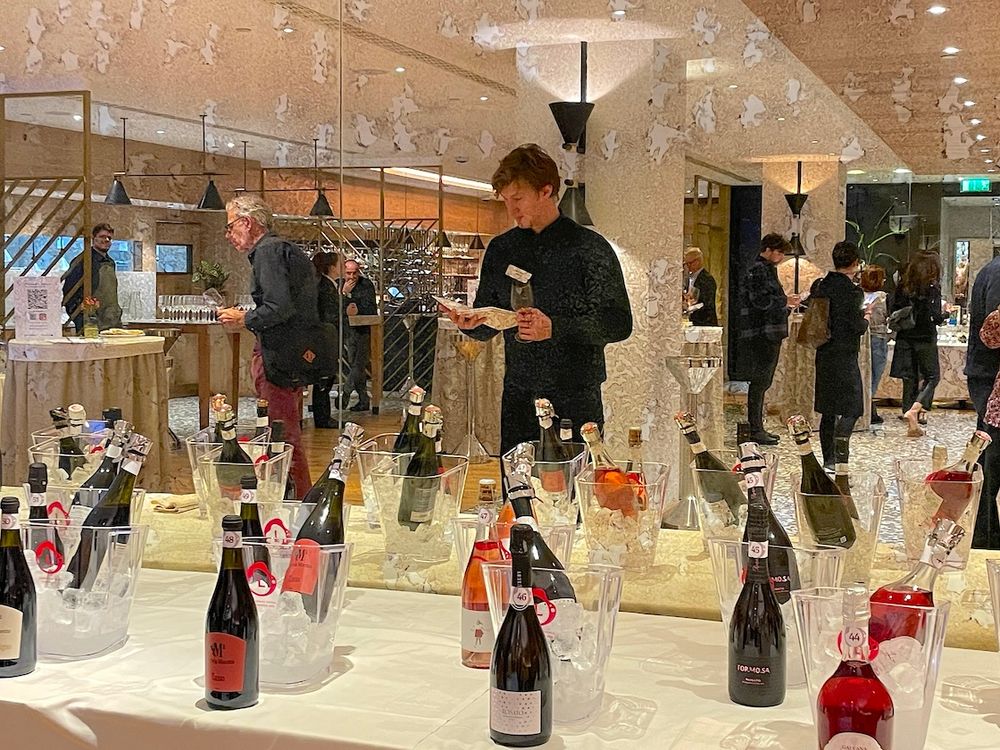On my way home from the recent Lambrusco Goes Large wine tasting, I met a neighbour on the train: “Wow! They’re still making that …” they exclaimed, on hearing what I’d been up to.
“Not only are they making it, but they’re also doing a bloomin good job!” I retorted and then finding my Lambrusco rhythm, began echoing Master of Wine, Ray O’Connor’s words… “Lambrusco might be the most pertinent and of-the-moment wine in the world right now.”

Lambrusco Goes Large tasting, London, November 18, 2024
Lambrusco ticks three crucial boxes in the wine ‘here and now’. It’s sparkling, the prices are refreshingly competitive, and the alcohol levels sit desirably around 11% abv, give or take a percentage point or two.
The tasting also drew my attention to a trio of additional winning points. From deep, dark red to lipstick rosy, and those with just the faintest pinkish hue, Lambrusco comes in a host of colours and styles to meet every taste. Some of the wines have terrific gastronomic potential: they come, after all, from the land of salt-cured pork, butter and the sort of rich cuisine that has a magical local partner in the dry, refreshingly acidic, toothsome and flavourful Lambrusco wines. Perhaps most winningly of all, the wines of Lambrusco are charmingly and refreshingly different.
Lambrusco essentials

There are six denominations: Colli di Scandiano e di Canossa; Lambrusco di Sorbara, Lambrusco Grasparossa di Castelvetro; Lambrusco Salamino di Santa Croce; Modena and Reggiano. Covering 10,000 hectares, the 17 cooperatives are influential and they, along with a host of dynamic, and well-travelled young winemakers, are breathing new life into Lambrusco.
There are twelve native red grape varieties allowed, with the rules of each DOC allowing for different blends and/ or mono-varietals. The three to know are: Lambrusco di Sorbara; Lambrusco Salamino and Lambrusco Grasparossa. The latter is the most full-bodied and tannic of the three. It also has ladles of those heady morello cherry and damson plum flavours, that some of us most commonly associate with Lambrusco. Sorbara is at the other end of the spectrum, its fruit profile is summer berry and redcurrant. Salamino sits somewhere between the two, with O’Connor citing “violet, rose and red berries” as its principle characteristics.
Sparkling Lambrusco is made either ‘ancestrale’ (the second fermentation taking place in bottle) or ‘charmat’ (second fermentation in tank). The charmat wines are, as you’d expect, more lightly sparkling.
It is a joy to report that it wasn’t hard to find wines to recommend at this tasting. I left in such a good mood you’d have to wonder if there’s such a thing as a Lambrusco Day in the biodynamic calendar!
I have limited my top picks to those wines which currently have UK representation.
A delightful duo of Sorbara wines

Cleto Chiarli Lambrusco del Fondatore, Lambrusco di Sorbara 11.5%
A traditional label and a lovely deep cherry red appearance invites you to this wine that is laden with summer blue and black hedgerow and elderberry fruit. There’s a refreshing line of acidity here, and you can imagine a second glass being hugely appealing. (Liberty Wines, £19.00 RRP).
From the same estate comes:
Cleto Chiarli Lambrusco del Fondatore, Vecchia Modena Premium, 11%
This is a slightly softer and lighter Lambrusco. A charmat method wine, the fruit is reminiscent of a summer red berry pudding. A refreshing mouthful of wine. (Liberty Wines, £18.00 RRP).
Salamino: A solo star, or a fine partner

Cantina Ventiventi Lambrusco Salamino di Sante Croce 2020 12%
Thishad a really appealing zip and tang to its floral, rich red berry fruit. Surprisingly moreish. (Spiegel & Peach, £25-£30 RRP)
Cleto Chiarli Lambrusco del Fondatore, Pruno Nero, Lambrusco di Modena 10.5%was a frizzante with spectacular oomph! I just loved its figgy, prune and cherries dipped in chocolate character, the pertinent tannins and impressive underscore of citrus acidity. Here was a wine crying out for a shoulder of pork and a handful of crackling. 50% Salamino / 50% Grasparossa. (Liberty Wines, £14.00 RRP)
Grasparossa: A richly expressive grape

Cantina Settecani Vini del Re Lambrusco Grasparossa 11%
really impressed. A gorgeous mouthful of frothy dark, ripe red stone fruits. A touch of spice too on this generous, long-loved Lambrusco. Another wine that will shine brightest with food. (Alivini, £18.90 RRP)
Impressively consistent, Cleto Chiarli delivered another gem with its Cleto Chiarli Lambrusco del Fondatore, Vigneto Cialdini 11%.
Savoury, earthy and gamey with oodles of liquorice sprinkled dark fruits. Again, notable tannins and refreshing acidity make this both hugely drinkable and a creative choice for sommeliers. (Liberty Wines, £16 RRP).
Lambrusco is Amabile too! Cantina Settecani Tradizione Amabile 8% has 45g/l residual sugar and 7.5 g/l total acidity. I enjoyed it because it’s fun, fruity and comes with a decent mousse and that all important zip of acidity. It’s the sort of unpretentious, light-hearted drinking that customers enjoy and will come back to time and again. (Alivini, £12.90 RRP).
In conclusion...
I confess, Lambrusco had fallen off my wine radar. It is firmly back on it now. The wines carry their craftmanship lightly, and with a good deal of fun at their core. It would be an error of judgement to not take them seriously. Lambrusco wines can be seriously loveable!
































